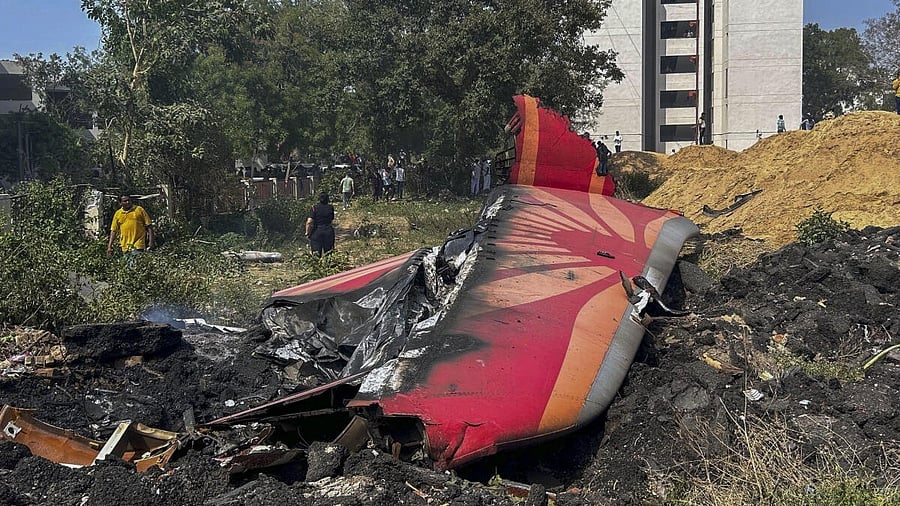
People near the debris of the Air India plane that crashed moments after taking off from the airport, in Ahmedabad.
Credit: PTI File Photo
Both of Air India Flight 171's engines lost power in just one second. This was so unlikely and terrible that it went against every level of current aviation design, aviation experts have said.
The Aircraft Accident Investigation Bureau (AAIB), which late on Friday released a preliminary report on its investigation into the crash, said it happened because both engines' fuel-control switches were moved to the "cutoff" position simultaneously during takeoff from Ahmedabad. This stopped thrust just as the Boeing 787 Dreamliner was starting to climb.
A series of events beyond human error — which no checklist, no automation, no training could arrest in time — followed. There are countless physical safety barriers to ensure that fuel control switches aren’t accidentally toggled on. These switches are critical since they regulate the supply of fuel to the engines.
The switches moving to “cutoff” within a second of each other defies fundamental principles of aircraft design, which rests on the premise that such failures are “practically impossible”, an aviation expert said.
The aircraft lost all thrust as both engines were shut down. The power systems failed, triggering the RAM Air Turbine (RAT) — an emergency backup device that indicates a complete loss of electrical power on board.
The Dreamliner was now a powerless glider at just 500 ft above the ground — too low to restore thrust, too slow to escape the aerodynamic drag it was subjected to, and too close to the ground for any recovery manoeuvre.
Flight data and cockpit voice recordings indicate that the pilots were quick to react. The levers were swiftly returned to the “run” position, restoring the fuel flow. However, the systems weren’t designed to recover that swiftly while climbing, as they needed the highest amount of thrust at that time.
The landing gear had also not been retracted yet, which exacerbated drag further and took away any little lift the aircraft could have utilised to gain some altitude. It was impossible to recover from the power loss, aerodynamic drag, and lack of height.
Perhaps the most disquieting aspect of the crash was the airline’s decision to ignore an advisory issued in 2018 in the wake of another airline’s report of a glitch in Boeing planes' fuel control switch design in December 2017.
It pointed out a risk that the switch's locking feature could become unlocked, allowing inadvertent movement between the fuel supply and cutoff positions. This was a mistake the locking mechanism was intended to prevent.
At the time, the United States' Federal Aviation Administration (FAA) had determined that the issue did not meet the threshold of an “unsafe condition”, thereby not issuing a mandatory directive. Thus, operators were strongly encouraged to inspect and rectify the issue. However, this was a voluntary advisory.
The AAIB report said Air India didn’t perform the recommended checks, stating that the bulletin was non-mandatory. The decision, while falling within the regulatory ambit, is the subject of intense ethical debate.
(The author is a Bengaluru-based senior journalist)